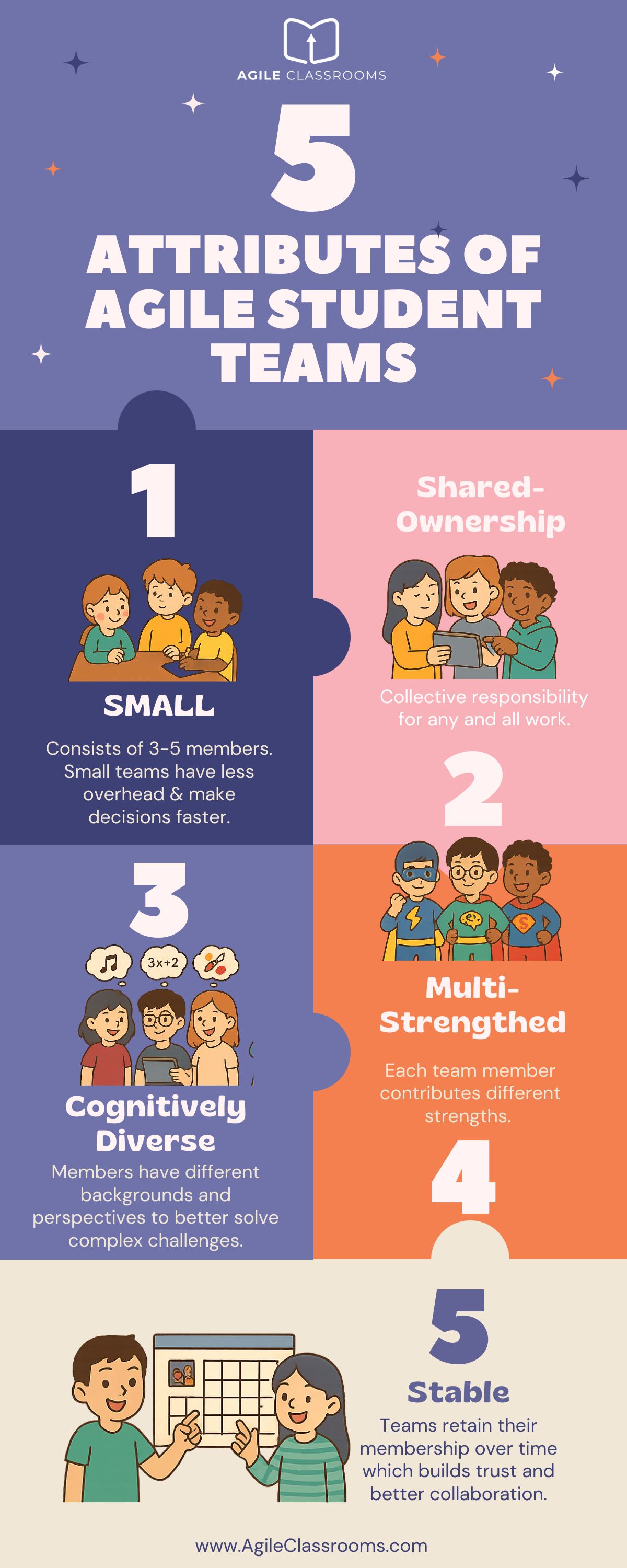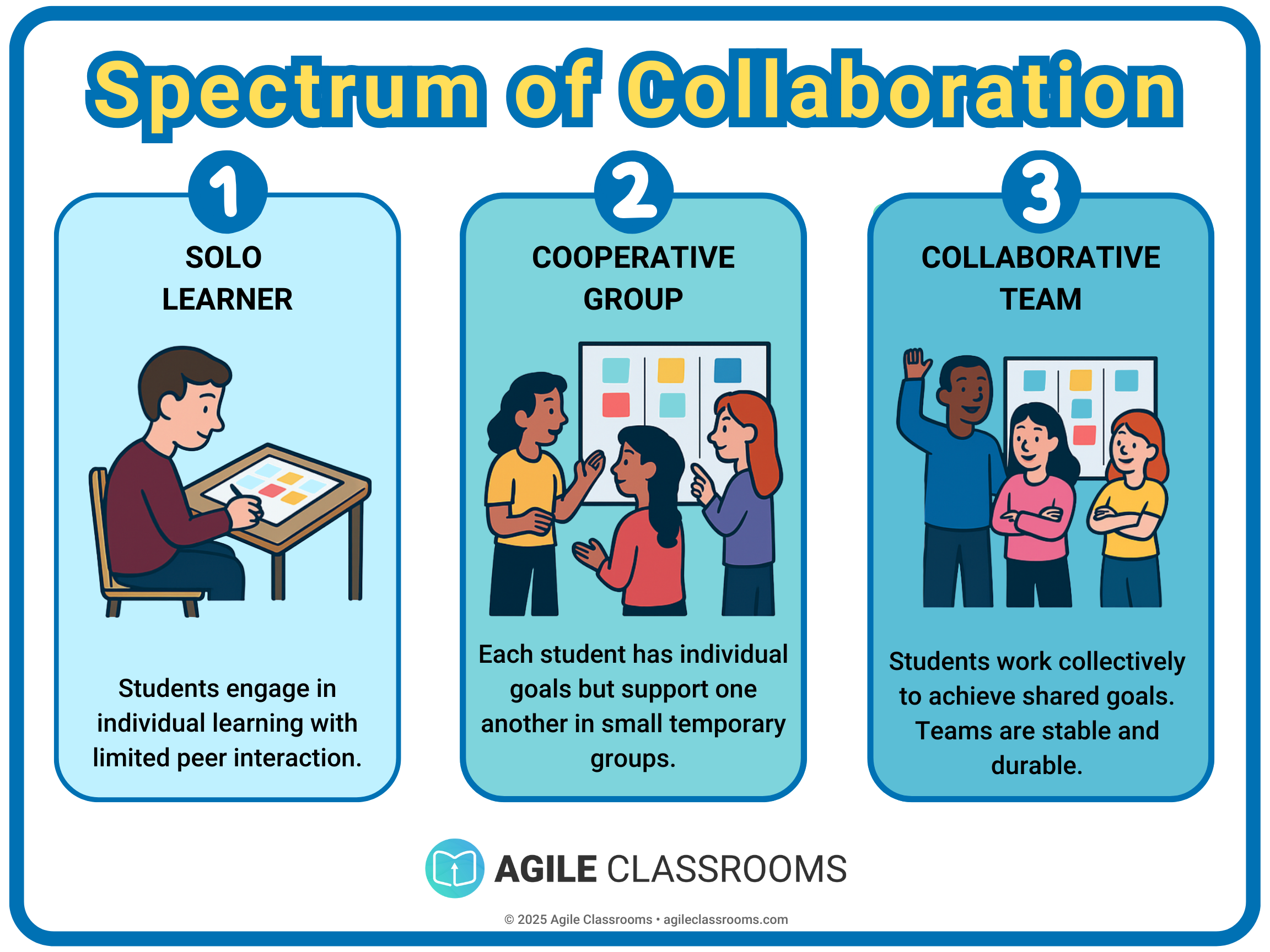Don't Miss an Article
Join thousands of other innovators receiving our newsletter.
Why Real Teams Matter in Agile Classrooms
- K12 Edu | .25 PDU/SEU/CEUs
Developing effective teaming skills is essential for future readiness.
In a world characterized by complexity and constant change, success depends on real teams, not just groups. A central goal of Agile Classrooms is cultivating students' abilities to collaborate effectively in genuine team settings.
Agile Classrooms deliberately form real student teams, defined by specific, research-backed attributes that significantly enhance student collaboration and learning outcomes.
Want to see how this fits into the broader system? Learn more about the Agile Classrooms Framework.
Defining Characteristics of Real Student Teams
Research consistently shows that intentional team formation matters greatly. Agile Classrooms leverage six key characteristics of real teams, each rooted in robust evidence—and visualized in the Agile Student Teams infographic below.

Small (3–5 students)
Promotes active involvement, equitable participation, and clearer communication.
Reduces decision-making time and peer accountability dilution.
Minimizes coordination complexity and social loafing common in larger groups.
Reinforces engagement through closer peer connections (Oakley et al.; Gladwell).
Shared Ownership
Encourages mutual responsibility, leading to higher commitment and trust.
Students collaboratively tackle tasks, fostering "we" over "me" dynamics.
Reduces teacher dependency while increasing intrinsic motivation.
Mirrors professional collaboration and builds relational accountability (Leading Educators; HBR).
Cognitive Diversity
Combines varied thinking styles for broader analysis and deeper insights.
Supports higher-order DOK levels like strategic and extended thinking.
Improves team adaptability, innovation, and performance accuracy.
Peer feedback in diverse groups enhances critical reflection and synthesis (HBR; PMC).
Did you know? Teams with moderate cognitive diversity show up to 58% better problem-solving accuracy and 15% more creative solutions than homogeneous groups.
Multi-Strengthed
Leverages diverse talents (research, creativity, leadership, etc.) for complex challenges.
Encourages peer mentoring and reciprocal teaching.
Reduces bottlenecks by distributing cognitive and task load.
Builds team resilience through complementary skill sets (PMC).
This characteristic supports perspective bridging, better self-assessment, and transactive memory—core ingredients for handling complex academic challenges.
Stable and Long-Lasting
Deepens psychological safety and trust over time.
Fosters a shared language, norms, and effective team habits.
Increases feedback quality and supports iterative learning.
Reflects real-world team dynamics that evolve through repeated collaboration (UTEP).
Stability doesn't just improve performance—it creates the space for students to take risks, reflect, and grow.
Self-Managing
Empowers students to own their processes, timelines, and accountability.
Develops autonomy, initiative, and real-world readiness.
Encourages teams to self-correct, plan, and problem-solve.
Builds foundational leadership skills through peer governance (Forbes).
Students in self-managing teams learn to lead without dominating—and follow without disengaging.
Peer Accountability and Its Impact
Peer accountability significantly enhances motivation, engagement, and academic performance. Malcolm Gladwell emphasizes the motivating power of peer expectations, noting students often feel more accountable to their peers than authority figures. Peer accountability structures foster intrinsic motivation, cooperative behaviors, and goal-setting abilities (Evidence Based Education), directly boosting overall academic achievement and team effectiveness (Gladwell; HBR).
Why Real Teams Outperform Traditional Groups
Traditional group work frequently suffers from insufficient structure and uneven accountability, leading to poor participation and unequal workloads (CSTA). Real teams, however, demonstrate clear alignment, deep collaboration, and strong commitment. This results in faster decision-making, enhanced trust, clearer communication, higher engagement, and greater innovation.
Real teams function more like a professional basketball team—connected, strategic, and able to adjust mid-play—rather than a pickup game where players may not even know each other’s names.
Gradual Transition to Effective Teams
Students often find collaborative teamwork initially challenging, highlighting the need for gradual scaffolding. Agile Classrooms adopt the Spectrum of Collaboration to progressively support student transition from independent activities to fully collaborative teamwork. Research supports this approach, indicating collaborative behaviors, experimentation, and trust-building grow substantially over time, as students develop stronger team identities.
This structured transition prepares students effectively for both educational and professional teamwork environments.
Ready to help your students develop exceptional teamwork skills?
Explore the Spectrum of Collaboration and start nurturing real student teams that grow and succeed together.
🏅 Earn 0.25 SEUs/PDUs for reading this! Renew your PMP, CSM, or CSPO certification.
Enjoyed this post? Let’s keep going.
Whether you're leading a team, managing a product, or transforming a classroom, I have resources to help you work smarter and get real results.
Click below for what works for you:
Free Resources
More Articles
Engaging Workshops
About John
Hey, I’m John. I help leaders, educators, and product innovators work smarter and build things that matter.
I cut through the noise to bring modern methods that actually work. Whether it’s leadership, product management, or education, the goal is the same—less friction, more impact. No fluff. No jargon. Just real-world insights to help you get better, faster.
💡 What You’ll Get Here:
✔ Smarter ways to lead and collaborate without the micromanaging
✔ Fresh, no-nonsense takes on modern work and education
✔ Tools and tactics to make work easier, faster, and more effective
Work doesn’t have to be chaotic.
Let's connect!
